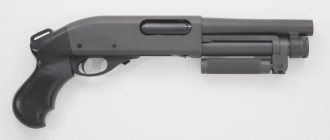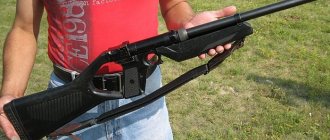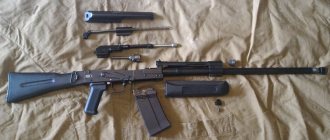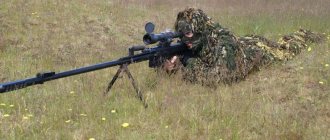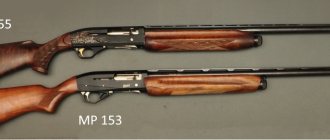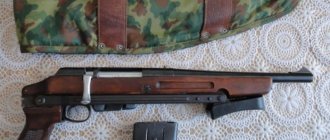The Pancor Jackhammer is one of the most exciting semi-automatic shotguns ever designed. Its creator, John Andersen, an American weapons designer, developed this shotgun to arm the police and army, but neither of them paid enough attention to this gun, and mass production was not established. Perhaps this was largely provoked by the non-standard design of the shotgun, which scared off conservative government officials - the police and the military. But, despite this, the Jackhammer was and remains a very interesting specimen among the entire variety of firearms.
Pancor Jackhammer
Specifications
The Pancor Jackhammer is a smoothbore semi-automatic shotgun. Moreover, its drum is designed for two types of cartridges: 12 mm “Magnum” and a shock cartridge called “Black Jack”. It also has a loud 130 dB boom that stuns the enemy. This weapon has the following technical indicators:
- caliber - 12 mm;
- barrel - 525 mm;
- gun length - 787 mm;
- weight - 4.57 kg;
- firing rate - 240/min;
- effective firing range - 150 m,
- Drum capacity - 10 rounds.
Pancor Jackhammer with scope
Links[edit]
- ^ abcdefg McCollum, Ian (September 12, 2015), "Pancor Jackhammer: The Real One", Forgotten Weapons
, Youtube - Glaser, Jonathan. "Pancor Jackhammer". Movie Gun Services.
- ^B Bishop, Chris (2006). Encyclopedia of Weapons: From World War II to the Present
. San Diego, CA: Thunder Bay Press. item 355. - ^ ab Hogg, Ian W. (1994), Jane's Infantry Weapons 1994–1995
, Jane's Information Group
Peculiarities
One of the features of the Jackhammer shotgun is that the barrel of this shotgun can be quickly replaced if necessary. To do this, you need to remove the muzzle, rotate the barrel ninety degrees and, moving forward, remove it along with the return spring. Then you need to do the same in reverse order with the new barrel.
The layout of the shotgun is made according to the bullpup type, which, although it is a very common design in conventional small arms, is quite rare among shotguns.
Manual reloading for the first shot, or after a misfire, is carried out when the forend moves. In this case, special hooks move the barrel forward and then backward, completing a full cycle and triggering the reloading mechanism and cocking of the gun.
Jackhammer has two types of stores. The first is loaded with a regular 12-gauge cartridge, and you can easily load it yourself. To do this, you need to disconnect the drum from the shotgun by pressing the trigger halfway, and then move the forend forward to the maximum. The drum will separate as the barrel and the cassette mounting axis move forward. The forend and barrel will be secured with a latch, which is attached to the front of the trigger guard. Thus, after removing the drum from the weapon, holding the weapon by the handle, you should insert a new charge.
Disassembled Pancor Jackhammer
The other magazine contains not a cartridge, but a different type of projectile, with buckshot or a bullet without a case. To load a shotgun, the shooter must first tear off a special film from the drum, and then load it into the weapon.
Also, at the beginning of the design, the Jackhammer had an interesting feature - it was designed to move in water. The shotgun came with a perfectly sealed container that prevented moisture from penetrating into the gun.
Shotgun Pancor Jackhammer
| Pancor Jackhammer Mk3A1 with interchangeable drum |
The American automatic revolver-type shotgun “Pancor Jackhammer” (literally translated as “jackhammer”) is intended for arming the police and army.
A version was also developed for arming combat swimmers, which differed from the standard version in that it had a sealed container for transporting weapons under water.
On the civilian weapons market in most countries, the sale of Pancor Jackhammer is prohibited.
Pancor Jackhammer cross-section
The main feature is that the gun is fed with cartridges from a 10-round 12-gauge hunting drum. The Pancor Jackhammer automatic operates by removing some of the powder gases from the barrel, and is reminiscent of the cylinder rotation mechanism of the 1896 Webley-Fosbery revolver.
The Jackhammer combat smoothbore automatic shotgun was developed in 1978 by weapons designer John A. Anderson specifically as a military model.
In 1984, Andersen patented the basic design, on the basis of which all further development of this weapon was based. The technical solutions implemented in the design of this gun were patented in the USA on December 1, 1987 under the numbers 4709617 and 4856410 and on January 4, 1990 in England under the numbers 2179429 and 2206188.
The first sample of the Pancor Jackhammer was released in 1985, the first tests were carried out in the 1990s.
However, the Pancor Jackhammer shotgun
but the weapons were not accepted.
The gun was initially advertised under the banner of Pancor Corporation, and later - Mark Three Corporation (which had in its arsenal a number of equally original and equally unsuccessful developments in the field of small arms).
Pancor Jackhammer shotgun device
The Pancor Jackhammer smoothbore shotgun is built according to the bullpup design.
The weapon is built on the basis of a gas exhaust mechanism with a forward-moving barrel and power from detachable magazines - drums like revolvers.
The automatic gas engine consists of a gas cylinder formed around the barrel and an annular gas piston rigidly mounted on the barrel. After the shot, hot powder gases enter the gas cylinder through a hole in the barrel and, acting on the gas piston, push the movable barrel forward, compressing the return spring. In this case, the barrel first disengages from the fired chamber of the drum, and then, through a longitudinally sliding lever located above the barrel (automation drive rod), it activates the reloading and cocking mechanism of the trigger mechanism.
There are special oblique shaped grooves on the outer surface of the magazine-drum. Two protrusions at the rear of the drive rod interact with these slots, causing the drum to rotate half a step clockwise, first as the rod (and barrel) moves forward and then backward. Thus, before the barrel reaches its rearmost position under the action of the return spring, the drum turns toward the barrel with the next loaded chamber. At the end of its return stroke, the barrel enters with its shank into the front part of the drum chamber, providing a tight connection that prevents powder gases from breaking out. At the same time, the rear end of the drive rod cocks the striker-fired firing mechanism.
The Pancor Jackhammer shotgun has an automatic fire mode only; Single shots are possible by briefly pressing the trigger due to the relatively low rate of fire.
Manual reloading for the first shot or in case of misfire is carried out by a movable fore-end, moving forward and backward, while special hooks inside the fore-end pick up the barrel and move it back and forth, carrying out a full reloading cycle.
Pancor Jackhammer incomplete disassembly
The change of magazines - drums (in the original bearing the brand name “Ammo Cassette” - a cassette with ammunition) was also carried out in an unusual way.
To separate the magazine from the weapon, you need to squeeze the trigger halfway, and then push the movable forend forward until it stops. In this case, the barrel will move forward, disconnecting from the drum, the tubular axis of the magazine will also move forward from the drum, allowing it to freely fall out of the weapon. In the forward position, the forend and barrel will be automatically locked with a special latch located in the front of the trigger guard. Thus, while holding the pistol grip with one hand, the shooter with the other free hand can insert a new magazine into place and then release the forend by pressing the latch. In this case, the magazine axis will fall into place, the drive lever will automatically align one of the drum chambers opposite the barrel, and then the barrel will enter this chamber with its rear part. The trigger will also be cocked automatically and the weapon will be ready for battle.
Pancor Jackhammer 2019
In the opening of the butt behind the magazine there is a handle connected to the firing pin and allowing, if necessary, to manually cock the firing pin or remove it from combat cocking.
Another feature of the Jackhammer shotgun is the ability to quickly change the barrel. To do this, you need to remove the muzzle, rotate the barrel 90 degrees around its axis and remove it forward along with the return spring. Then insert the new barrel, rotate it 90 degrees so that it engages the drive rod, then put the recoil spring on the barrel and install the muzzle in place.
| Caliber, mm | 12 |
| Length, mm | 787 |
| Barrel length, mm | 525 |
| Weight without cartridges, kg | 4.57 |
| Drum capacity, no. cartridges | 10 |
| Rate of fire, rds/min | 240 |
| Sighting range, m | 40 |
To supply the Jackhammer, two types of magazines were provided. The first type had ordinary chambers designed for special reinforced 12-gauge cartridges. After removal from the weapon, such a magazine could be freed from empty cartridges and reloaded with cartridges. The second type of magazine must be loaded at the factory, with gunpowder, projectile (buckshot, bullet, etc.) and primer loaded directly into the drum, without cartridges. The fully equipped drum (“Ammo Cassette”) was hermetically packaged in plastic film and was to be delivered to users in this form. Before loading, the shooter had to tear off the plastic wrapping from the drum and load it into the weapon, and after using up all the charges, throw it away (or, if the situation allows, save it for later return to the factory for reloading).
Based on such stores, Andersen also developed a special anti-personnel mine, the Bear Trap, which featured a fuse attached to the store. When it was triggered, charges from all chambers were fired simultaneously, creating the effect of a directed fragmentation mine.
Single fire from the Pancor Jackhammer is achieved with jerky trigger pulls and a low rate of fire. The safety lever is located above the handle, on the left side of the weapon. When turned on, it blocks the trigger rod and trigger.
The sight of the weapon is open, consisting of a bar closed on the sides, like on hunting rifles.
Operating principle
The automatic operation of the Jackhammer Mk3 operates thanks to a gas cylinder and a piston rigidly attached to the barrel. Gases from the combustion of gunpowder under pressure enter the cylinder, and then push the gas piston and push the movable barrel forward, compressing the return spring for the next shot. This happens due to the movement of the automation drive rod, sliding longitudinally along the barrel. Thanks to this, the barrel is disconnected from the drum chamber, after which the reloading mechanism is activated.
The cassette drum moves due to special grooves made on the outside of it. The automation drive rod acts on them, causing the cassette to rotate - at first half a step forward clockwise, and then in the opposite direction as the rod and barrel move. Thanks to this mechanism, the drum rotates towards the barrel with a chamber containing a cartridge to fire a shot. To avoid the exhaust of powder gases between them, at the end of the backward movement, the barrel fits hermetically into the drum with its shank. Also during this process, the drive rod automatically cocks the trigger due to the movement of the rear end of the barrel, and the weapon can immediately be used in combat.
Recommendations
- ^ a b c d f f gram
McCollum, Ian (September 12, 2015), "Pancor Jackhammer: The Real One",
Forgotten Weapons
, YouTube - Glaser, Jonathan. "Pancor jackhammer." Movie Gun Services.
- ^ a b
Bishop, Chris (2006).
Encyclopedia of Weapons: From World War II to the Present
. San Diego, CA: Thunder Bay Press. item 355. - ^ a b
Hogg, Ian W. (1994),
Jane's Infantry Weapons 1994–1995
, Jane Information Group
Design
The Pancor Jackhammer, a gas-operated smoothbore shotgun, has a bullpup design, which also makes it different from typical shotguns, which use a different structure and mechanism. “Jackhammer” - this is the literal translation of the name of the gun - is a semi-automatic shotgun, and the mechanism of this gun has only an automatic fire mode. One can only be shot with short presses of the trigger. The gun fires quite fast for a shotgun - 4 shots per second, but this does not interfere with single shots. This also sets the Jackhammer apart from other shotguns - the trigger mechanism allows the shooter to fire up to 240 shots in 60 seconds. Jackhammer's magazines resemble a revolving drum. In its structure and principle of operation, it is vaguely similar to the drum of the old English revolver made in 1896, which became the prototype for many similar guns - the Fosbery produced by Webley & Scott.
The gun consists of seven main parts, which are made using both steel and plastic. This is polyethylene reinforced with fiberglass - “Rainit SST”. You can carry the gun by holding the handle, specially designed for this purpose. The front and rear sights are also attached to it, open, like on a hunting rifle. Externally, the weapon is beautiful and overall has a rather futuristic design with the most streamlined shapes possible. It consists of a muzzle, a barrel, a housing in which the trigger mechanism is attached, a butt, a drum and a return spring.
The axis of rotation of the cassette - the magazine of this shotgun, a drum called “Ammo Cassette” - is fixed on the trigger mechanism. The special muzzle of the Jackhammer shotgun has a beveled cut in the front part and is a compensator (this is not a reliable fact, since it is too large, but barrel flip can indeed be reduced due to the action of the muzzle).
A particularly interesting part of the shotgun is the cassette drum - when a special detonator is installed in it, it turns into an anti-personnel mine called “Trap Bear” - a bear trap. This mechanism was also designed by John Andersen along with the entire shotgun and is also an interesting feature of this particular weapon.
Media fame
The non-standard appearance of the Pancor Jackhammer shotgun attracted the attention of game and movie creators. This model can be found in many games and movies.
The popularity of this model of shotgun has brought a number of advantages that cannot be avoided:
- brutal appearance;
- pretentious name (literal translation - jackhammer);
- fashionable bullpup layout;
- a hefty drum loaded with hefty cartridges;
- semi-automatic version.
In the game Max Payne, the Jackhammer was the best shotgun, although, unlike the original, the magazine already held 12 rounds. Far Cry, Battlefield 2 and 3, Ranbow Six 3, 7.62 and many other games also adopted this model.
The Pancor Jackhammer is one of the most unusual and truly interesting shotguns ever made. It has both power and rate of fire, and, if necessary, the ability to use it as a mine against ground infantry. The Jackhammer was designed specifically as a military shotgun, and it is truly a versatile and unusual shotgun that is worth checking out. It differs in many ways from the standard weapons on the market, but nevertheless it was never accepted for service.
Modifications
The prototype shotgun was first introduced back in 1978 by the Pancor Corporation, and it was called the Mk3. Subsequently, on the basis of this design, all other further modifications were made aimed at improving the weapon.
The first modification of this shotgun, patented in 1984, was the Mk3 A1. This model received the most design changes and, in fact, this modification remains the only significant change that was ever made to the Pancor Jackhammer design. As a result of this modification, the shape of the gun became even more streamlined, thereby reducing the weight of the shotgun. This was partly due to improved barrel cooling. The operation of the automation has become somewhat smoother due to changes in the grooves of the drum, and the mechanism has become noticeably quieter. And it was with this version that the shotgun became equipped with the ability to manually cock the trigger.
Changes made to its mechanism were made in 1987 and 1990. The Jackhammer was not accepted for use by the US Army; very few copies of this weapon were produced, just a few working prototypes.
Development[edit]
The jackhammer was developed by John A. Anderson, who founded Pancor Industries in New Mexico. Anderson designed it based on his experience using pump-action shotguns during the Korean War and believed he could create a better shotgun, finding reloading pump-action shotguns inconvenient and time-consuming. [1] Several foreign governments reportedly showed interest in the design and even ordered the first production units when they were ready for delivery. [1] However, export of the design was suspended due to US Department of Defense testing, although the design was ultimately rejected. Testing was carried out by HP White Labs in destructive tests (destruction of two out of three produced). Of those sent to HP White Labs, 4 lb (1.8 kg) of material was reportedly removed using heavy-duty stamping instead of casting and another simpler reloading method. Thus, the only surviving example does not indicate what might have been an actual production model, and is better regarded as a tool room prototype. Several dozen non-functional specimens were made from tin, balsa wood and clay to make working tool prototypes. Civilian sales became impossible due to the US classification of the jackhammer as a machine gun and restrictions on machine gun production enacted in 1986. Additionally, those foreign governments that expressed interest were unwilling to finance development and final production. [1] With no customers and little interest, Pancor went bankrupt. The proposed foreign orders were subject to approval by the US State Department, which was not forthcoming. Pancor's assets were sold off, including the construction of several prototypes. [12]
